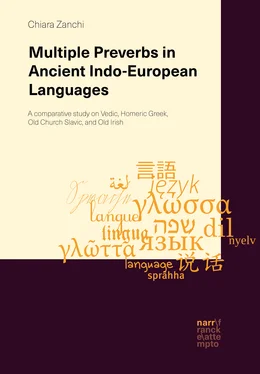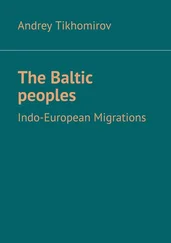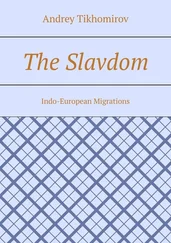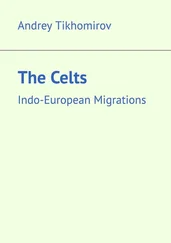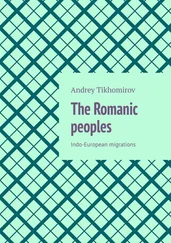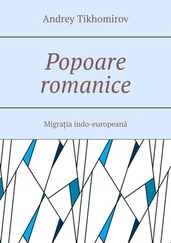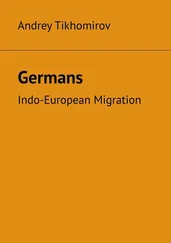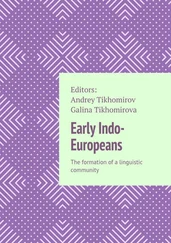Purpose : this SR is taken by an entity, often a state of affairs, aimed by the intentional activity of an Agent. Such SR is often expressed through allative markers, or markers of Beneficiary or of Cause.
Instrument: this SR is prototypically taken by an inanimate and manipulated entity that is used by an Agent to carry out an action. Being an inanimate entity, Instrument differs from Agent in the properties of intentionality and control.
Comitative : this SR prototypically involves an animate Agent performing an action together with another animate individuated entity, which carries out the same action.
Location: the SR of an entity (LM) that gives information about the position or the spatial orientation of another entity (TR).
Goal : the SR of an entity (LM) that individuates a portion of space toward which another entity (TR) moves along a trajectory.
Source : the SR of an entity (LM) that individuates a portion of space away from which another entity (TR) moves along a trajectory.
Path : this SR describes the portion of space that a TR covers while performing a motion.
Time: this SR describes either the temporal placement or the Duration (LM) of a certain event (TR). Notably, the event conceived as a TR appears either to be located within/before/after or to last a given amount of time, conceived as a LM. Time cross-linguistically tends to be conceptualized in terms of space (Haspelmath 1997). These two conceptual domains are mapped by means of the metaphor TIME IS SPACE (Lakoff & Johnson 1980; Claudi & Heine 1986).
Manner : this SR refers to the way in which an action, a state of affairs, an experience or a process is brought about.
Area: the SR of the thematic context or field within which an event is seen; it specifies the extent to which the state of affairs denoted by the verb applies.
Location : the SR of an inanimate LM that gives information about the position or the spatial orientation of another entity or event (TR).
2.3.2. Aspect, actionality, and transitivity
2.3.2.1. Aspect and actionality: terminological and conceptual issues
Since their introduction into linguistic terminology and discussion, the notions of “aspect” and “actionality” have long overlapped and been confused (cf. among others Viti 2008a; 2008b; Danesi 2009: 9ff.).
The term aspect is the translational equivalent for Russian vid, which was first employed in Greč’s (1827) grammar of Russian to describe the ability of certain affixes to derive perfective and imperfective verbs from the same root. Later on, Curtius (1846) extended the notion of aspect to Indo-European languages other than Slavic, specifically to the Ancient Greek verbal system. Curtius’ terminology comprises the terms Zeitart (literally) ‘temporal modality’, including past, present and future tenses, and Zeitstufe (literally) ‘temporal layer’, including notions such as durativity, ingressivity, and completion. Brugmann (1885) and Delbrück (1897) introduced the terms Aktion and Aktionsart (literally) ‘actional modality, actionality’ , distinguishing among punctual, iterative, durative, and terminative events. The term Aktionsart was also used by Streitberg (1900), who ascribed to this category five different values, including the perfective.
In the early 20 thcentury, the term Aspekt also officially entered the linguistic discussion thanks to the slavist Sigurd Agrell. In his grammar of Polish (Agrell 1908), he distinguished the categories of Aspekt ‘aspect’, which refers to the completeness-incompleteness of the action, and of Aktionsart , which describes the way in which the action is carried out (e.g., according to Agrell, definitive, effective, augmentative, perdurative, and others). These two notions were later on kept distinct, for example by Jacobsohn (1926), who assigned a subjective character to Aspekt , but an objective value to Aktionsart (cf. Section 2.3.2.2) . Krause (1953) also separated the two notions in a similar manner.
After the introduction of the concept of Aspekt early in the 20 thcentury, the two categories of Aspekt ‘aspect’ and Aktionsart ‘actionality’ continued to be confused, and scholars exhibited – and to some extents still do – little agreement on the definition, scope, and values of these terms (cf. Bertinetto 1986; Bybee, Perkins & Pagliuca 1994; Sasse 2002; Tatevosov 2002; Croft 2012; and Filip 2012 for a thorough discussion of this issue). The confusion was especially apparent in 20 thcentury discussions of the Ancient Greek verbal system, in particular when it came to the description of the dichotomy between aorist and present tenses, and to the role of preverbs (cf. Brugmann &Thumb 1913; Meillet 1922; Meillet &Vendryes 1924; Ruipérez 1954). Precisely because of this terminological fuzziness, perfectivizing value was ascribed to Ancient Greek (but also to Vedic) preverbs (cf. Chapters 4 and 5), based on the much more grammaticalized perfective-imperfective opposition expressed through Slavic preverbs (i.e. “prefixes”, cf. Chapter 3 on terminology; Chapter 6 on Old Church Slavic).
In recent decades, the so-called bidimensional approach to aspect, which clearly distinguishes Aspekt and Aktionsart , has been the most widely employed within the field of Indo-European studies (cf. Strunk 1994; García Ramón 2002; Sasse 2002; Napoli 2006; Dahl 2010; Cotticelli-Kurras 2015; by contrast, cf. Inglese 2016, who, in his analysis of Hittite lexical aspect, adopted Croft’s cognitive approach, on which see below). Within the bidimensional approach, on the one hand, aspect, or more precisely “grammatical aspect”, encodes the grammatical expression of speakers’ viewpoint on events. On the other hand, Aktionsart, or “lexical aspect”, or “actionality”, is usually regarded as an objective, or inherent, feature of verbal roots, which can be classified into different categories accordingly (cf. Vendler 1957; Section 2.3.2.2). Recently, the bidimensional approach has been brought into question within various theoretical frameworks, including Cognitive Grammar, which does not allow for any clear-cut distinction between the layers of lexicon and syntax (cf. Section 2.1). In Croft’s (2012) recent monograph, for example, grammatical and lexical aspects are not distinguished, as they both emerge from the interaction between the idiosyncratic facets of verbal semantics, and the specific semantics of the constructions in which verbs occur. In the following sections, I provide very brief definitions of both aspect and actionality as they are used in this work, and discuss their interplay (Section 2.3.2.2), as well as the interaction between actionality and transitivity (Section 2.3.2.3).
2.3.2.2. Aspect and actionality: definitions, values, and their interplay
The category of grammatical aspect expresses the way in which speakers view an event, that is, speakers’ subjective perspective on the event, encoded through grammatical means (cf. Vendler 1957; Comrie 1976; Bertinetto 1986; Bybee, Perkins & Pagliuca 1994; Rothstein 2004). The notion of grammatical aspect is related to that of time, which expresses the relation between the moment of speaking and the time of the situation described. Present tense is seen as simultaneous to the moment of speaking, past tense as previous to the moment of speaking, and future tense as subsequent to the moment of speaking (Comrie 1976: 2). Thus, time is a deictic category, in that it is anchored to the spatiotemporal context created by the participants in a conversation (Lyons 1977: 637). In contrast, grammatical aspect has nothing to do with deixis, but rather interacts with speakers’ perspective in a different way: “aspects are different ways of viewing the internal temporal constituency of a situation” (Comrie 1976: 3). Comrie thus points out two major factors defining the category, specifically (a) speakers’ viewpoint, (b) the internal setting of a certain event itself (and not its temporal reference) (cf. also Bertinetto 1986: 76).
Читать дальше
